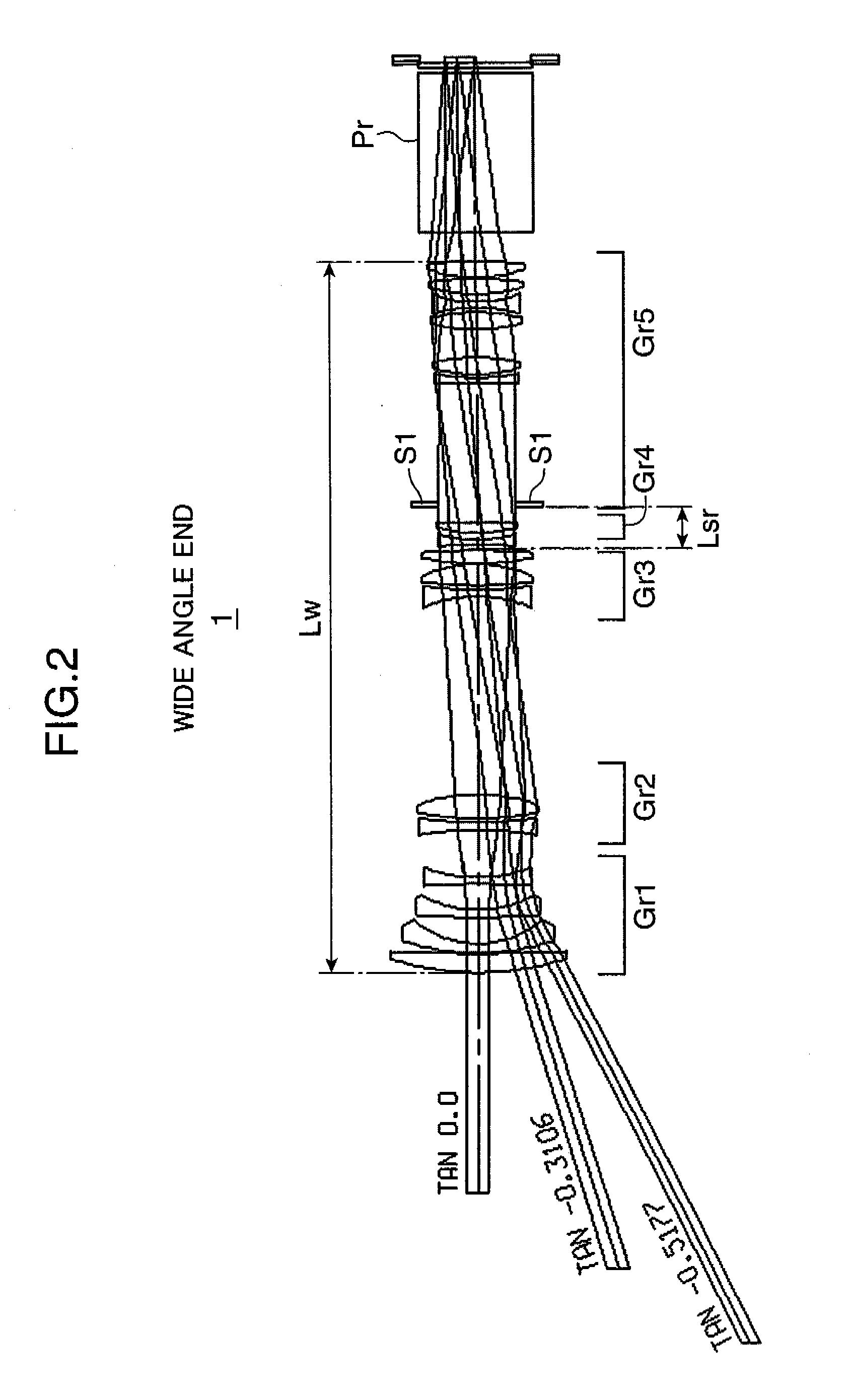Projection lens and projector
a projection lens and projector technology, applied in the field of projection lenses, can solve the problems of increased production cost, difficult to obtain optimal lens arrangement, increased etc., and achieve the effect of sufficient correction of lateral chromatic aberration, and less number of lens elements
- Summary
- Abstract
- Description
- Claims
- Application Information
AI Technical Summary
Benefits of technology
Problems solved by technology
Method used
Image
Examples
first embodiment
[0048]In this section, described is an example, wherein a projection lens in accordance with the first embodiment of the invention is applied to a projector. FIG. 24 is a diagram showing the entire arrangement of a projector in accordance with the first embodiment. FIG. 1 is a lens arrangement diagram of a projection lens in accordance with the first embodiment.
[0049]FIG. 2 is an optical path diagram of the projection lens at a wide-angle end. FIG. 3 is an optical path diagram of the projection lens in a middle focal length position between the wide-angle end and a telephoto end. FIG. 4 is an optical path diagram of the projection lens at the telephoto end.
[0050]As shown in FIG. 24, the projector includes a screen 2, an image generator 3 for generating an image by modulating light, a projection lens 1 for projecting an image onto the screen 2, a light source 4, an illumination optical system 5 for guiding light from the light source 4 to the image generator 3, a prism Pr constituted...
example 1
[0078]In this section, Example 1 of the projection lens 1 in accordance with the first embodiment is described. Construction data of lens elements in Example 1 is as follows. CR indicates a curvature radius of a lens surface of each lens element. T indicates a distance (on-axis distance between lens surfaces) between lens surfaces on the optical axis in an infinite focus position. Nd indicates a refractive index of each lens element with respect to d-line. Vd indicates the Abbe number of each lens element with respect to d-line. The lens surface attached with the symbol ri (i=1, 2, 3, . . . ) indicates the i-th lens surface from the enlargement side.
unit: mmlens surface numberCRTNdVd 1159.12010.1011.516864.2 21150.4570.300 3129.8895.0001.4874970.44 454.18113.898 5408.2304.0991.6229958.12 660.31813.793 7−388.5643.7241.6031160.69 885.750variable 9−163.2774.0001.6200436.2910203.0282.17211167.91013.2351.71353.9412−84.834variable13−74.1253.7521.5317248.8414210.0042.28815254.43511.3171.48...
second embodiment
[0082]FIG. 10 is a lens arrangement diagram of a projection lens 1 in accordance with the second embodiment of the invention. Description on elements in the second embodiment substantially identical or equivalent to those in the first embodiment is omitted herein. As shown in FIG. 10, the projection lens 1 for use in a projector is constituted of a first lens group Gr1 having a negative power, a second lens group Gr2 having a positive power, a third lens group Gr3 having a negative power, and a fourth lens group Gr4 having a positive power. The second and the third lens groups Gr2 and Gr3 serve as movable lens groups, and the second lens group Gr2 serves as a movable lens group having a maximum moving amount.
[0083]The first lens group Gr1 is constituted of lens elements L1 through L6. The second lens group Gr2 is constituted of lens elements L7 through L9. The third lens group Gr3 is constituted of lens elements L10 and L11. The fourth lens group Gr4 is constituted of lens elements ...
PUM
 Login to View More
Login to View More Abstract
Description
Claims
Application Information
 Login to View More
Login to View More - R&D
- Intellectual Property
- Life Sciences
- Materials
- Tech Scout
- Unparalleled Data Quality
- Higher Quality Content
- 60% Fewer Hallucinations
Browse by: Latest US Patents, China's latest patents, Technical Efficacy Thesaurus, Application Domain, Technology Topic, Popular Technical Reports.
© 2025 PatSnap. All rights reserved.Legal|Privacy policy|Modern Slavery Act Transparency Statement|Sitemap|About US| Contact US: help@patsnap.com



